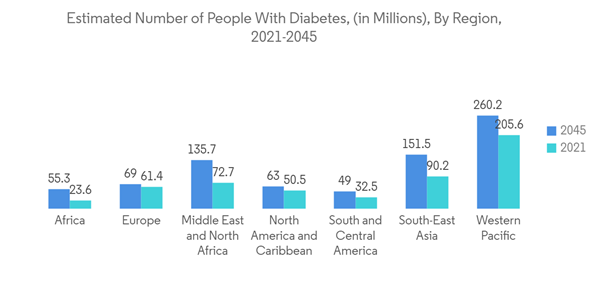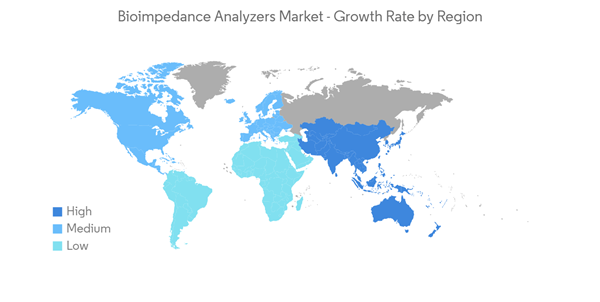The COVID-19 pandemic was expected to have a significant impact on market growth. This was mainly due to the high risk of obesity during the pandemic period. For instance, according to the article published in Diabetes Obesity and Metabolism in August 2021, obesity prevalence is a significant and potentially modifiable risk factor among COVID-19 patients. Therefore, the demand for bioimpedance analyzers is expected to increase as the risk of contracting COVID-19 remains high for obese patients. Additionally, due to changing lifestyles and an increase in home delivery, many individuals are consuming incredibly unhealthy prepared food. These behaviors could lead to an increase in body fat. Thus, rising obesity and related metabolic disorders among the population are expected to increase the demand for bioimpedance meters for precise assessment of muscle versus body fat and analyzing health risks associated with high fat in the body, thus expected to augment the market growth.
Certain factors that are propelling market growth are the increasing prevalence of metabolic disorders, rising government initiatives to promote healthy lifestyles, and emerging technological advancements.
The increasing incidences and prevalence of metabolic disorders such as diabetes, Gaucher's disease, glucose-galactose malabsorption, hereditary hemochromatosis, maple syrup urine disease (MSUD), phenylketonuria (PKU), and others are expected to be the major factor driving the demand for bioimpedance analyzers, thereby boosting the market growth. For instance, according to the International Diabetes Federation (IDF) data published in 2021, globally, there were 537 million people years affected by diabetes aged between 20-79 in 2021. Also, the same source mentioned that number of diabetes cases is expected to reach 783 million across the world. Additionally, the Gaucher's Institute article, updated in November 2021, reported that Gaucher's disease is equally prevalent in males and females and has a worldwide prevalence of 0.70 to 1.75 per 100,000 individuals annually. As per the same source, the standardized birth incidence of Gaucher's disease within the general population varies from 0.39 to 5.80 per 100,000 individuals annually. This disorder causes an inability to break down a certain type of fat, causing it to build up in the liver, spleen, and bone marrow, preventing the organs to work consistently. Thus, the disease can be clinically managed by incorporating an individualized nutrition assessment plan, considering the patient's energy requirements and mode of feeding. Therefore, the increasing burden of metabolic disorders is expected to increase the demand for bioimpedance analyzers owing to the effective management of the disorders, thereby fueling the market growth.
In addition, the rising government initiatives to promote a healthy lifestyle and achieve a healthy weight with improved well-being are also expected to boost market growth over the forecast period. For instance, in July 2021, the United Kingdom government launched National Health Service (NHS) Digital Weight Management Programme, which is supported by EUR 12 million (USD 12.75 million) in government funding. This program provides persons with obesity who are also diagnosed with diabetes, high blood pressure, or both free online support via referrals from a General Physician (GPs) and primary care teams.
Moreover, the rising technological advancements and increasing product launches are expected to boost the market's growth over the forecast period. For instance, in November 2021, BodyPedia launched its smart scale on Kickstarter, the body fat scale with 97% accuracy, to rehabilitate bioelectrical impendence analysis technology. This device provides accurate body composition report with body circumference to restore the reputation of bio-electrical impedance analysis technology.
However, inconsistency and inaccuracy in different analyzers are likely to restrain the market growth over the forecast period.
Bioimpedance Analyzers Market Trends
Multi-frequency Bioimpedance Analysis Segment Expected to Witness the Highest Growth During the Forecast Period
Multi-frequency Bioelectrical Impedance Analysis (MF-BIA) is a relatively simple and quick method to measure body composition. It also enables the estimation of the percentage of muscle tissues, hydration levels, bone weight, metabolic rate, and fitness levels. In addition, MF-BIA devices are relatively cheap, portable, and do not require specialist training for use.The factors propelling the growth of multi-frequency bioimpedance analyzers are increasing the utilization of these analyzers in assessing body composition and rising product launches. For instance, according to an article published by the BMC Journal, in February 2022, it has been observed that when comparing the body fat mass of COPD patients, multi-frequency bioelectrical impedance devices can be a reliable substitute. Similarly, according to an article published by Frontiers in Cardiovascular Medicine in April 2021, it has been observed that multi-frequency bioimpedance analyzers provide accurate and distinct measurements in patients with and without heart diseases. It provides a unique additional tool to aid in clinical decision-making for the patients. Thus, such evidence from increasing research studies proves the potential benefits of multi-frequency bioimpedance analyzers are likely to increase their demand, thereby fueling segment growth.
Moreover, the increasing product launches and rising company activities for the development of technologically advanced bioimpedance analyzers are expected to boost segment growth over the forecast period. For instance, in January 2022, Withings launched Withings Body Scan with multi-frequency Bioelectrical Impedance Analysis. The product contains four weight sensors and promises body weight accuracy to within 50 grams (or, for a 200-pound person, accuracy to an impressive 0.025%). The device also has 14 ITO electrodes within the platform and four stainless steel electrodes in a retractable handle. These sensors gather data for the six-lead ECG and segmental body composition analysis.
Thus, the aforementioned factors are expected to increase the demand and utilization of multi-frequency bioimpedance analyzers to assess the body composition among the population, thereby boosting segment growth over the forecast period.
North America is Expected to Hold Significant Market Share During the Forecast Period
North America is expected to account for the largest share of the bioimpedance analyzers market. The growth of the bioimpedance analyzers market in the region is attributed to various factors, such as increases in obesity rates, increasing healthcare spending, a growing number of fitness centers and health clubs, and an increasing geriatric population.The growing geriatric population who are more likely to develop various metabolic disorders such as diabetes, Gaucher's disease, and others are expected to increase the demand for assessing body composition for further treatment, thereby boosting the market growth. For instance, in the report published by America Health Ranking 2022, there were more than 55.6 million adults aged 65 and older in the United States in 2021, and this number is expected to reach 73.1 million by 2030. Additionally, the data published in the National Library of Medicine in December 2021, mentioned that with an incidence of 1 in 300 to 500 people annually, hereditary hemochromatosis is the most prevalent autosomal recessive condition among Americans. Such prevalence of metabolic disorders is also expected to contribute to the growth of the studied market.
Furthermore, the article published in Nature Journals in April 2021 mentioned that the prevalence of metabolic disorder syndromes in Canada was 25% in 2021. Such a high prevalence of metabolic disorders is expected to contribute to the demand for bioimpedance analyzers, thereby contributing to the growth of the market in this region.
Bioimpedance Analyzers Industry Overview
The Bioimpedance Analyzers market is highly competitive and consists of several major players. Companies like Tanita Corporation, Akern, Biodynamics Corporation, Bioparhom, Biotekna, Bodystat Ltd, Charder Electronic Co. Ltd, Evolt 360, Fook Tin Group Holding Ltd, InBody Co. Ltd, Lumsail Industrial Inc., Maltron International, Omron Corporation, RJL Systems, Seca GmbH & Co. KG, SELVAS Healthcare Inc., Sino-Hero, and Withings hold substantial market shares.Additional Benefits:
- The market estimate (ME) sheet in Excel format
- 3 months of analyst support
This product will be delivered within 2 business days.
Table of Contents
Companies Mentioned (Partial List)
A selection of companies mentioned in this report includes, but is not limited to:
- Akern
- Biodynamics Corporation
- Bioparhom
- Tanita Corporation
- Biotekna
- Omron Corporation
- Bodystat Ltd
- Charder Electronic Co. Ltd
- EVOLT 360
- Fook Tin Group Holding Ltd
- InBody Co. Ltd
- Lumsail Industrial Inc.










